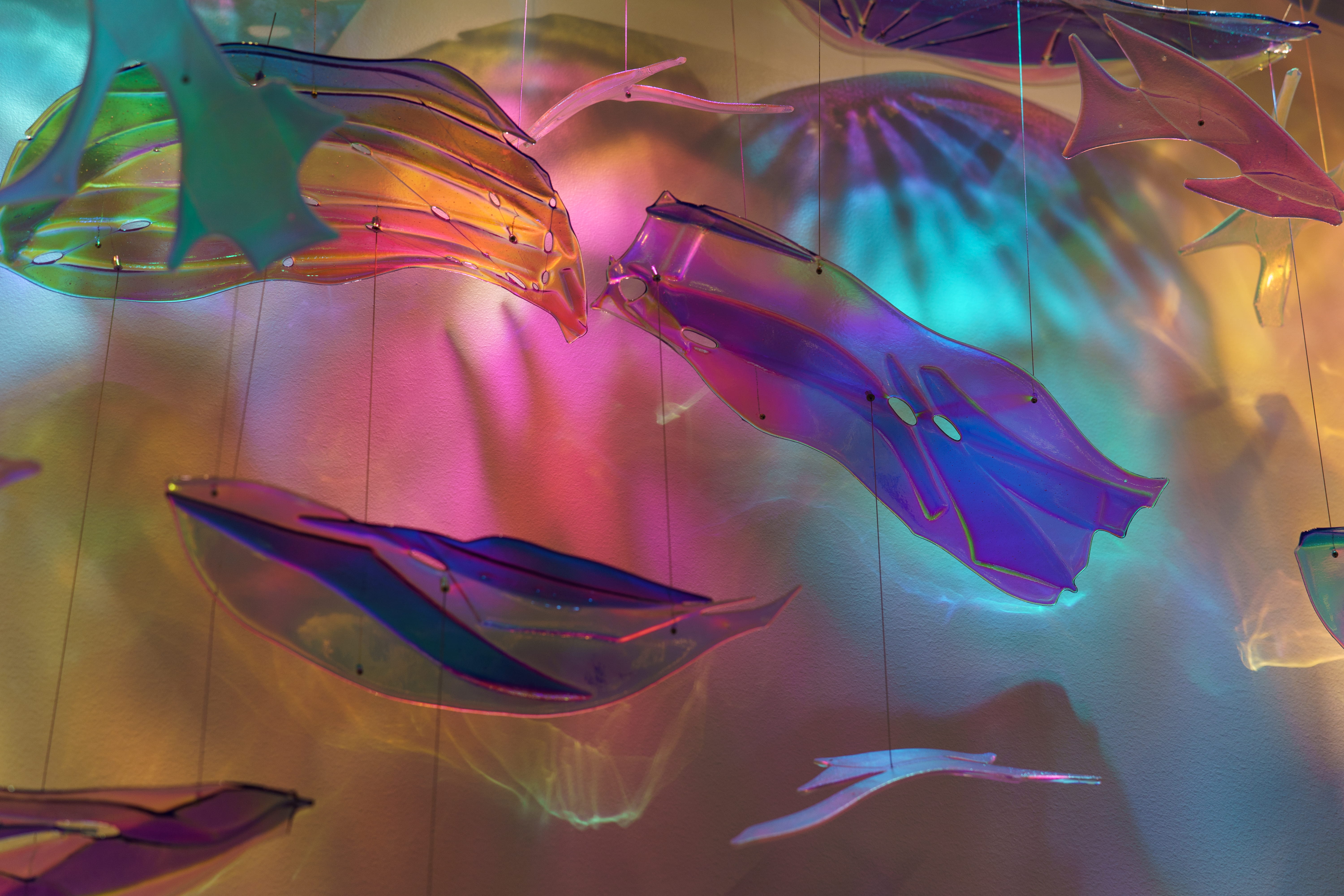
‘I want the glass to help calm them’
Inspired by childhood wonder and shaped by personal loss, Michele Gutlove’s luminous installation bathes the atrium of the Medical Education and Research Building in a sea of color, light and healing to create a place where art meets science.
Bobby King Jun 13, 2025
WHEN SHE WAS just four years old, artist Michele Gutlove remembers, her mother took her to an exhibition at the Guggenheim Museum in New York that featured the works of Alexander Calder, an American sculptor who revolutionized kinetic mobiles as an art form.
During the retrospective, Calder’s mobiles were suspended within the white seashell space of the Guggenheim’s spiral interior, creating an enchanting effect that Gutlove had to see on again and again on repeat visits. For Gutlove, that enchantment has lasted a lifetime.
“As my mother tells it, the story was that there wasn’t a coat hanger in the house that was safe from me because I was (reshaping) them and gluing paper to them,” Gutlove recalls. “The dream of making art that hangs in spaces has been with me my whole life.”
Gutlove, now 67, has been fulfilling that dream, hanging her mobile sculptures of handmade glass in schools, libraries, aquatic centers and government buildings across the United States and a few locations in Europe.
Her 51st art installation adorns two walls adjacent to the atrium of the new Medical Education and Research Building on the Indianapolis campus of the Indiana University School of Medicine. It was commissioned by Dean Jay L. Hess and his wife Robin, to honor the Vera Bradley Foundation for Breast Cancer Research, which has committed more than $50 million to breast cancer research at the School of Medicine since 1993. Hess lost his own mother to breast cancer.
Titled “Brightly,” the display features approximately 225 pieces of bent glass hung in four locations within the building. Each piece is illuminated by LED lights, which reflect brilliant colors and transmit images on the atrium’s white walls. And for the girl who fell in love with mobile art in the Guggenheim, Gutlove sees some similarities in the architecture of the IU structure — an elegant, white space with uninterrupted lines around a sunlit atrium.
For Gutlove, the project has special meaning. Her mother, Anne, was diagnosed with breast cancer when Michele was 13. She died 10 years later. “For about half my life, I knew her as a breast cancer patient,” she said.
Despite her mother being treated at a first-rate hospital by well-respected physicians, Gutlove has regrets about her care. The research has advanced, and the care for patients has improved today, she said. “Their futures are much brighter than what it was 40 years ago.”
The brightness of those futures was what she wanted to bring to this installation. Brightness also reflects the minds of the students and scientists who will learn and work in the building, she said. The displays produce a wide spectrum of colors that are evident in the glass, but also cast and stretch onto the building’s white walls — deep blues and vivid purples, pinks and greens, and many shades in-between.
In her studio just outside of Boston, Gutlove begins her process with clear or colored glass that comes to her crushed or in sheets. She melts the pieces down, uses her hands, or molds, or mere gravity to shape them. Then she drills holes in them for hanging.
The colors in the glass come from minerals used in the creation of the pieces. The reflections and shadows are created with a dichroic coating, a mineral oxide quartz crystal grown on the glass in a vacuum chamber. Another aspect of her creative manipulation of light — thin-film interference — occurs when light waves are reflected from different surfaces of a thin film. She thinks of this optic property — transmitting and reflecting opposite colors — as magic.
Glass with gold and yellow reflections will project on the walls shadows of cool blues. Glass with purple and violet reflections will project shadows of gold and amber.
The three-dimensional curves in the form of the glass tap into another aspect of optics to create “caustic” reflections — like those seen on the side of a boat or underneath a bridge when light hits water.
The pieces in the Medical Education and Research Building are formed into myriad shapes — some like birds or fish or butterflies, or maybe even neurons. Gutlove says she prefers to let the viewers make up their own minds.
“I want people to experience it however they want to experience it. So, I’m almost hesitant to say. I want them to see something in it — if it’s just a feeling of peace, if it’s a feeling of nice colors, or birds or jellyfish, or anything,” she said.
“If someone comes in here and feels scared, I want the glass to help calm them. If someone is in here and they’re feeling pessimistic, I want them to somehow feel optimistic. And for the scientists, I want to express gratitude.”
Video